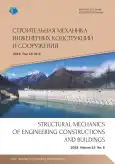Визуализация образования поверхностей полуправильных многогранников в среде AutoCAD
- Авторы: Романова В.А.1
-
Учреждения:
- Российский университет дружбы народов
- Выпуск: Том 15, № 6 (2019)
- Страницы: 449-457
- Раздел: Теория тонких оболочек
- URL: https://journal-vniispk.ru/1815-5235/article/view/346300
- DOI: https://doi.org/10.22363/1815-5235-2019-15-6-449-457
- ID: 346300
Цитировать
Полный текст
Аннотация
В статье рассматривается автоматизированное образование кинематическим методом поверхностей полуправильных многогранников Архимеда трех форм: усеченного тетраэдра, усеченного октаэдра и усеченного икосаэдра. Для решения поставленной задачи использовались AutoCAD и встроенный в него язык программирования AutoLISP. Каждый из указанных трех полуправильных многогранников Архимеда имеет грани двух видов. В связи с этим поверхность отдельного многогранника рассматривается состоящей из двух конструктивных форм. Каждая конструктивная форма образуется в среде AutoCAD из отсеков поверхностей граней многогранника одного вида, причем каждый отсек закрепляется за определенным слоем чертежа. Образование конструктивных форм обеспечивают пользовательские функции, разработанные на функциональном языке программирования AutoLISP. Пользовательские функции не только формируют образы поверхностей, но и выполняют все необходимые расчеты. Электронная модель каждого многогранника формируется объединением его конструктивных форм. Из нее создается блок. Образование поверхности каждого многогранника выполняют пользовательские функции, обеспечивающие «замораживание» слоев чертежа, предназначенных для отсеков поверхности, вставку блока с электронной моделью многогранника и последовательное «размораживание» слоев чертежа. Когда происходит «размораживание» слоев чертежа, процесс образования многогранника демонстрируется на экране монитора. Результатом проведенного исследования стало создание программного обеспечения, включающего пользовательские функции для формирования электронной модели выбранных многогранников и визуализации процесса образования их поверхностей в динамическом режиме.
Об авторах
Викторина Анатольевна Романова
Российский университет дружбы народов
Автор, ответственный за переписку.
Email: v.a.r-victoryna@mail.ru
доцент департамента строительства Инженерной академии
Российская Федерация, 117198, Москва, ул. Миклухо-Маклая, 6Список литературы
- Alexandrov A.D. (2005). Convex polyhedra. Berlin, Springer. https://www.springer.com/us/book/9783540231585
- Koroyev Yu.I. (2015). Nachertatel'naya geometriya [Drawing Geometry]. Moscow, KnoRus Publ. (In Russ.)
- Ashkinuz V.G. (1957). O chisle polupravil'nyh mnogogrannikov [On the Number of Semi-Control Polyhedra]. Mathematical Education, 2(1), 107–118. (In Russ.)
- Savchenko V. (1979). Polupravil'nye mnogogranniki [Semi-controlled polyhedral]. Quant, (1), 3. (In Russ.)
- Smirnova I.M., Smirnov V.A. (2010). Pravil'nye, polupravil'nye i zvezdchatye mnogogranniki [Correct, SemiControl and Star Polyhedra]. Moscow, MCNMO Publ. (In Russ.)
- Shchetnikov A.I. (2007). Luka Pacholi i ego traktat “O bozhestvennoj proporcii” [Luca Pacholi and his “On Divine Proportion”. Mathematical Education, 1(41), 33–44. (In Russ.)
- Vasilyeva V.N. (2019). Gold section and gold polygons in the construction of icosahedron, dodecahedron and bodies of Archimedes based on them. Geometry and graphics, 8(2), 47–55. DOI: 1012737/article_5d2c1ceb9f91b1.21353054. (In Russ.)
- Alsina K. (2014). Tysyacha granej geometricheskoj krasoty. Mnogogranniki [Thousand facets of geometric beauty. Polyhedra]. Moscow, DeAgostini Publ. (In Russ.)
- Motulsky R.S. (2007). Nacional'naya biblioteka Belarusi: novoe zdanie – novaya koncepciya razvitiya [National Library of Belarus: New Building – New Development Concept]. Minsk. (In Russ.)
- Shishova A.B. (2015). Polupravil'nye mnogogranniki [Semi-controlled polyhedral]. Concept, (25), 191–195. http://e-koncept.ru/2015/65341.htm. (In Russ.)
- Ertskina E.B., Korolkova N.N. (2016). Geometric Modeling in Automated Design of Architectural Objects. Geometry and Graphic, 4(2), 48–54. doi: 10.12737/19833. (In Russ.)
- Schroeder W., Martin K., Lorensen B. (2003). The Visualization Toolkit. Kitware, Inc.
- Haber R.B. (1990). Vizualization Techniques for Engineering Mechanics. Computing Systems in Engineering, 1(1), 37–50.
- Mihai Dupac, Claudiu-Ionut Popirlan. (2010, April 1). Web Technologies for Modelling and Visualization in Mechanical Engineering. doi: 10.5772/9037
- Gallagher R.S. (1994). Computer Visualization: Graphics Techniques for Engineering and Scientific Analysis. CRC Press, Solomon Press.
- Caha J., Vondráková A. (2017). Fuzzy Surface Visualization Using HSL Colour Model. Electronic Journal, 2(2), 26–42.
- Ivanov V.N., Krivoshapko S.N., Romanova V.A. (2017). Bases of development and visualization of objects of analytical surfaces and the prospect of their use in architecture and construction. Geometry and graphics, 5(4), 3–14. (In Russ.)
- Heifetz A.L., Loginovsky A.N., Butorina I.V., Vasilyev V.N. Vasil'eva V.N. (2015). Inzhenernaya 3D-komp'yuternaya grafika: uchebnik i praktikum dlya akademicheskogo bakalavriata [Engineering 3D computer graphics: textbook and workshop for academic baccalaureate]. Мoscow, YuRAYT Publ. (In Russ.)
- Ivanov V.N., Romanova V.A. (2016). Konstrukcionnye formy prostranstvennyh konstrukcij. Vizualizaciya poverhnostej v sistemah MathCad, AutoCad [Constructive forms of space constructions. Visualization of the surfaces at systems MathCAD, AutoCAD]. Moscow, ASV Publ. (In Russ.)
- Kukharchuk A.I., Romanova V.A. (2014). Visualization of the Solution of Graphic Problems. RUDN Journal of Engineering Researches, (1), 23–28. (In Russ.)
- Romanova V.A. (2014). Visualization of surface formation of umbrella type. Structural Mechanics of Engineering Constructions and Buildings, (3), 19–22. (In Russ.)
- Romanova V.A. (2016). Generation of cyclic surfaces with generating circle of variable radius in AUTOCADE. Structural Mechanics of Engineering Constructions and Buildings, (3), 20–24. (In Russ.)
- Romanova V.A. (2012). Features of the image of the process of surface formation in the AutoCAD system. Structural Mechanics of Engineering Constructions and Buildings, (4), 3–5. (In Russ.)
- Romanova V.A. (2019). Formation of Monja surfaces by kinematic way in the environment AutoCAD. Structural Mechanics of Engineering Constructions and Buildings, 15(2), 106–116. http://dx.doi.org/10.22363/18155235-2019-15-2-106-116. (In Russ.)
- Romanova V.A., Rynkovskaya M., Ivanov V. (2019). Automatic Modeling of Surfaces with Identical Slopes. Advanced Structured Materials, 92, 143–156. https://doi.org/ 10.1007/978-3-319-79005-3_10
- Romanova V.A. (2019). Visualization of regular polyhedrons in the process of their formation. Geometry and graphics, 7(1), 55–67. doi: 10.12737/article 5c91ff d0916d52/90296375. (In Russ.)
Дополнительные файлы









